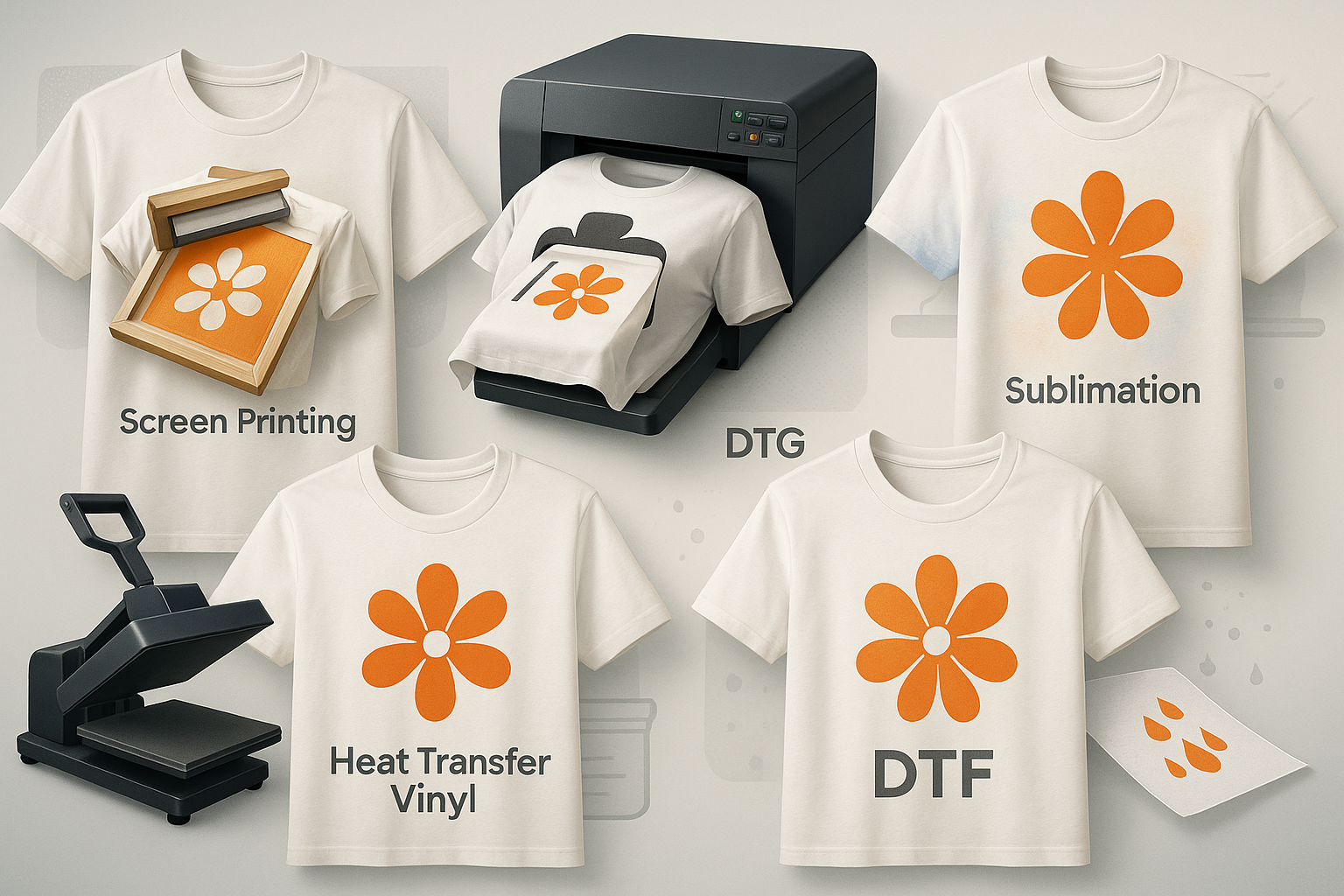The Ultimate Guide to T-Shirt Printing Techniques: Pros, Cons, Applications, and History

1. Screen Printing (Silk Screen)
History:
Dating back to ancient China (around 960 AD), screen printing became commercialized in the West during the 20th century. It became a go-to method for band merch and promotional apparel in the 1960s-70s.
How it works:
Ink is pushed through a mesh stencil (screen) onto fabric.
Pros:
- Vibrant colors
- Durable prints
- Cost-effective in bulk
Cons:
- Not ideal for small orders
- Complex for multicolor designs
- Setup takes time
Best For:
Bulk orders, corporate giveaways, simple graphic designs.
2. Direct-to-Garment (DTG)
History:
Emerging in the early 2000s, DTG was a game-changer, offering digital printing directly onto fabric—no screens needed.
How it works:
Like an inkjet printer for T-shirts—prints directly onto fabric.
Pros:
- Great for small runs and detailed designs
- Unlimited color options
- Quick setup
Cons:
- Works best on 100% cotton
- Less vibrant on dark fabrics
- Slower than screen printing for large volumes
Best For:
One-off prints, custom on-demand merch, photo-quality designs.
3. Heat Transfer / Vinyl Printing
History:
Gained popularity in the 80s with DIY and sports customization.
How it works:
A design is cut from vinyl or printed onto transfer paper and heat-pressed onto the T-shirt.
Pros:
- Good for small batches and personalization
- Easy to apply names and numbers
- Works on various materials
Cons:
- Less breathable prints
- May peel or crack over time
- Limited design complexity
Best For:
Team jerseys, limited-edition merch, and personalization.
4. Sublimation Printing
History:
Originally used in photography and transferred to fabric in the late 20th century, especially for polyester.
How it works:
Heat turns ink into gas, which embeds into synthetic fibers.
Pros:
- Super soft finish (ink is inside the fabric)
- Vibrant and long-lasting
- No cracking or fading
Cons:
- Only works on light-colored polyester
- Not suitable for cotton
- Requires special equipment
Best For:
Sportswear, performance gear, all-over prints.
5. Embroidery (Honorable Mention)
While not a printing method, embroidery is often considered for custom apparel.
Pros:
- Premium, long-lasting finish
- Great for logos and monograms
Cons:
- Limited color blending
- Not ideal for large or detailed graphics
Best For:
Corporate wear, caps, polos, and premium branding.
Learn More




Browse Products
Posted in:
Printing
Related posts
 Employee Gift Ideas for Every Milestone in the Journey
Employee Gift Ideas for Every Milestone in the Journey
Posted in:
Printing
28/05/2025
117
views
Employees are the heart of every organization—and recognizing their milestones with thoughtful gifts can boost...
Read more
 Learn How to Use Merch & Swag in Your Business
Learn How to Use Merch & Swag in Your Business
Posted in:
Printing
29/05/2025
164
views
Guides, Insights & the Latest Trends in Merchandise
In today’s world of remote teams, hyper-branding, and...
Read more
 Job Promotion Gift Ideas: Celebrate the Climb
Job Promotion Gift Ideas: Celebrate the Climb
Posted in:
Printing
30/05/2025
93
views
Job promotions are a defining moment in any professional’s career. It’s not just a title change - it’s recognition of...
Read more
 Project Completion Gift Ideas: Rewarding a Job Well Done
Project Completion Gift Ideas: Rewarding a Job Well Done
Posted in:
Printing
30/05/2025
80
views
Every completed project represents weeks or months of planning, teamwork, and execution. A project completion gift is...
Read more
 Sales Target Achievement Gift Ideas: Recognizing High Performers
Sales Target Achievement Gift Ideas: Recognizing High Performers
Posted in:
Printing
30/05/2025
122
views
Sales professionals thrive on goals - and they deserve more than just a pat on the back when they smash their...
Read more





Leave a comment